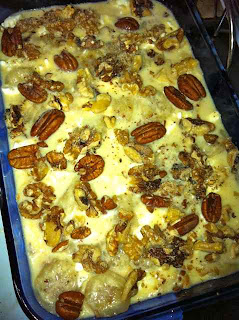This is paella made by brown rice without broth.
Because purine melts into water, any extract made from meat, fish, sea foods are high in purine, including canned broth, instant consomme, bouillons, and gravy.
(it depends on kind of broth, but around 30-40mg /100ml broth)
Not also that brown rice has more purine than white rice.
Brown rice : 37.4mg
white rice : 25.9mg
(per 100g)
Though if your body is acidic than alkaline,
uric acid gets crystalizes easily.
And brown rice or whole foods are alkaline.
<Here's how I usually make my paella>
* add broth instead of water in case if you don't have uric acid or gout problem.
1. Sauté garlic, then chopped onion in olive oil.
Wait until onion is cooked and becomes sweet, then add brown rice and sauté until rice is cooked in oil.
(This brown rice mix is blended at home using the kind of brown rices of my preference.)
2. Add paella seasoning, or spices you like.
Saffron can be used instead of paella mix, but since this rice has no broth, it means no flavor,
you can add some spices like cumin, celery powder, pimiento, paprika, or even chili powder.
Make sure to sauté spices until aroma comes out.
3. Add whole tomatos in can (I prefer produce of Italy).
I used to make paella without canned whole tomato, but just sauté chopped fresh tomatoes together with onions.
But tomatoes can help reducing uric acid according to Tufts univ research.
Besides, it gives flavor that can replace broth.
4. Add water 3 cups or so.
Don't worry about water, cause you can add gradually when it's nearly dry.
5. Now close the lid, and cook rice until rice is tender.
Constantly mix from the bottom to avoid burning.
6. Add water if water is almost dry, but rice is not yet cooked.
Add salt and pepper, too, and adjust the taste.
7. Cut lemon while waiting for the rice to cook.
8. Olives should be added earlier to give some flavor.
Green olive with seeds are preferable cause seeds can give extra flavor,
but it's up to you whether you put olive or not.
I used black olives cause I run out of green one.
Once the rice is cooked, get out the lid and make the water evaporated until dry on top.
9. I like to make the bottom part rice burn a bit.
You can add garnishes such as green bell pepper which I like to add raw, boiled tomatoes, and lemon.
My camera focussed on lemon and eggs rather than rice,
that's why the rice looks dark here.
And it's not that tasty as the one cooked in broth, but if you have other dished, then it can go with anything which have more flavors.




























